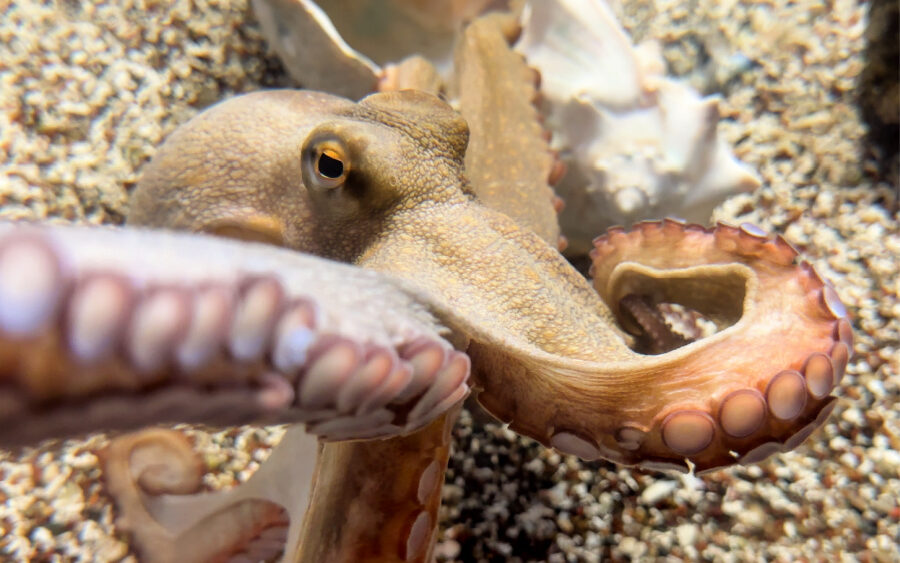Are you a sucker for cephalopods? Well, you’re in luck because October 8 begins International Cephalopod Awareness Days, and we’re here to deliver eight interesting facts about one of our favorite cephalopods and animal residents: the common octopus! Read on to learn more about these otherworldly creatures.
1. Cephalo…what?
Let’s start with the basics: What is a cephalopod? A cephalopod is any of the Cephalopoda class of marine mollusks. This label applies to more than just the octopus, though. Squids, cuttlefishes and nautiluses are also cephalopods. The word itself means “head foot” in Greek, a fitting description for animals that have multiple appendages, or tentacles, extending directly from their heads!
2. Beauty and Brains
Did you know octopuses have the largest and most developed brains and nervous system of all invertebrates? Scientists have observed octopuses demonstrating a variety of learning characteristics, such as the use of tools. For example, an octopus may find a discarded coconut husk and use it as a shelter. Octopuses have also demonstrated the ability to manipulate objects by pushing, pulling and even twisting things like jar lids! Because octopuses are so intelligent, they require a lot of mental and physical stimulation, which we provide with enrichment. As natural hunters, a common enrichment given to an octopus is a toy with food “hiding” inside, requiring them to manipulate the object in order to “catch” their prey!
 Our aquarists are creative when it comes to octopus enrichment!
Our aquarists are creative when it comes to octopus enrichment!3. Ink That’d Make a Tattoo Artist Jealous
The common octopus is also known for its ability to release black ink. We’re guessing a certain line from “Finding Nemo” comes to mind when you think of octopus ink, but this inking is less about emotion and more about survival. The common octopus releases a cloud of black ink during escape attempts when in danger. Their ink even clouds a predator’s sense of smell, making it more difficult to follow the escaping octopus! This ink is a mixture of mucus and melanin, the same substance that provides pigment in human skin, hair and nails.
4. To Beak or Not to Beak…
Did you know all cephalopods have beaks? That’s right — and they look strikingly similar to a parrot’s beak! The common octopus has a two-part beak which it uses to eat crunchy prey like crabs and clams. Mostly made of chitin, the beak is indigestible, meaning you could tell if a predator snacked on an octopus!
5. Born to Stand Out, But Ready to Blend In
While the common octopus is a hunter armed with a super-sharp beak for offensive maneuvers, they utilize a different talent for defense. As you may have noticed in our Camouflage exhibit here at the Aquarium, the common octopus can instantly change its color and even its texture to blend into its surroundings! This is accomplished through a network of pigment cells called chromatophores within its skin. The common octopus has mastered this camouflage so well that even the fiercest of predators can swim right by without noticing!
 Would you be able to spot this camouflaged octopus on the ocean floor?
Would you be able to spot this camouflaged octopus on the ocean floor?6. More to Love
The common octopus has three hearts! One main heart circulates blood throughout the body, and two smaller hearts are each positioned next to a set of gills. And along with their eight “arms” and three hearts, some consider octopuses to have nine brains. A central brain functions with overall control, but each tentacle can act independently with its own “mini brain”!
7. It’s the Circle of Life
The common octopus makes a big impact in a small amount of time. These intelligent creatures have a life span of up to two years. Octopuses are considered semelparous animals, meaning they only reproduce once in their lifetime. So while they may not have long lives, we can be confident that the octopus plays an integral role in the ocean ecosystem in which they thrive.
8. Worthy of a “World’s Greatest Mom” Mug
A single female octopus can lay up to 500,000 eggs! Eggs are laid in strands attached to substrate in shallow waters. The female then cares for the eggs and stands guard until they are all hatched. Although the mature female perishes after this process, thousands of nearly microscopic octopuses emerge and swim away to begin this amazing cycle again!
 Newly hatched octopuses, called larvae, are mere millimeters in length!
Newly hatched octopuses, called larvae, are mere millimeters in length!Well, if cephalopods didn’t octopi your heart before, we hope they do now! In honor of International Cephalopod Awareness Days, take some time to celebrate the cephalopods that never cease to amaze, and don’t forget to visit the common octopus during your next Aquarium visit!
Published October 8, 2022


